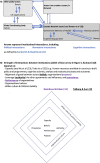Influences on policy-formulation, decision-making, organisation and management for maternal, newborn and child health in Bangladesh, Ethiopia, Malawi and Uganda: The roles and legitimacy of a multi-country network
- PMID: 37988328
- PMCID: PMC10662733
- DOI: 10.1371/journal.pgph.0001742
Influences on policy-formulation, decision-making, organisation and management for maternal, newborn and child health in Bangladesh, Ethiopia, Malawi and Uganda: The roles and legitimacy of a multi-country network
Abstract
The Network for Improving Quality of Care for Maternal, Newborn and Child Health (QCN) is intended to facilitate learning, action, leadership and accountability for improving quality of care in member countries. This requires legitimacy-a network's right to exert power within national contexts. This is reflected, for example, in a government's buy-in and perceived ownership of the work of the network. During 2019-2022 we conducted iterative rounds of stakeholder interviews, observations of meetings, document review, and hospital observations in Bangladesh, Ethiopia, Malawi, Uganda and at the global level. We developed a framework drawing on three models: Tallberg and Zurn which conceptualizes legitimacy of international organisations dependent on their features, the legitimation process and beliefs of audiences; Nasiritousi and Faber, which looks at legitimacy in terms of problem, purpose, procedure, and performance of institutions; Sanderink and Nasiritousi, to characterize networks in terms of political, normative and cognitive interactions. We used thematic analysis to characterize, compare and contrast institutional interactions in a cross-case synthesis to determine salient features. Political and normative interactions were favourable within and between countries and at global level since collective decisions, collaborative efforts, and commitment to QCN goals were observed at all levels. Sharing resources and common principles were not common between network countries, indicating limits of the network. Cognitive interactions-those related to information sharing and transfer of ideas-were more challenging, with the bi-directional transfer, synthesis and harmonization of concepts and methods, being largely absent among and within countries. These may be required for increasing government ownership of QCN work, the embeddedness of the network, and its legitimacy. While we find evidence supporting the legitimacy of QCN from the perspective of country governments, further work and time are required for governments to own and embed the work of QCN in routine care.
Copyright: © 2023 Akter et al. This is an open access article distributed under the terms of the Creative Commons Attribution License, which permits unrestricted use, distribution, and reproduction in any medium, provided the original author and source are credited.
Conflict of interest statement
The authors have declared that no competing interests exist.
Figures


References
-
- The Network for Improving Quality of Care for Maternal Newborn and Child Health. Quality, Equity, Dignity. A Network for Improving Quality of Care for Maternal, Newborn and Child Health (see http://www.qualityofcarenetwork.org/ (accessed 21 Dec 2022) for details) 2022.
-
- World Health Organization. The Network For Improving Quality of Care for Maternal, Newborn, and Child Health. Evolution, Implementation and Progress. 2017–2020 Report. Geneva: WHO, 2021.
-
- Shawar Y., Djellouli N., Shiffman J., Akter K., Kinney M. V., Mwaba K., et al. (2023). "Factors Shaping Network Emergence: A Cross-Country Comparison of Quality of Care Networks in Bangladesh, Ethiopia, Malawi & Uganda. PLOS Global Public Health (under review). or Medrxiv preprint 31st March 2023: 10.1101/2023.03.29.23287925 https://www.medrxiv.org/content/10.1101/2023.03.29.23287925v1 - DOI - DOI - PMC - PubMed
-
- Djellouli N., Shawar Y. R., Mwaba K., Akter K., Seruwagi G., Tufa A. A., et al. (2023). "Effectiveness of a multi-country implementation-focused network on quality of care: delivery of interventions and processes for improved maternal, newborn and child health outcomes " PLOS Global Public Health (under review). or Medrxiv preprint 5th March 2023 10.1101/2023.03.03.23286747 https://www.medrxiv.org/content/10.1101/2023.03.03.23286747v1 - DOI - DOI - PMC - PubMed
Grants and funding
LinkOut - more resources
Full Text Sources
